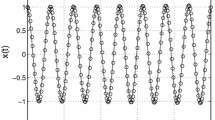Abstract
An electro-optical method is proposed for an alternative solution of the radio technical problem of stroboscopic recording and regeneration of ultrashort (nanosecond) radio pulses with subnanosecond resolution, which represent signatures of the radio image of irradiated objects for radiosensor signal-tomographic authentication systems. Software models of infraoptic repeaters are developed in the Simulink environment to numerically analyze and study the efficiency of the method of optical regeneration of radio pulses using a fractional multiplexing scheme with delayed feedback. A radio response from a digital twin of a target irradiated with a Gaussian ultrashort radio pulse is simulated with the aid of the Altair Feko electrodynamic simulation software. It is shown that an electro-optical repeater with 16 delay lines allows regeneration of a radio response from a target in 20 iterations with a correlation coefficient of greater than 0.9 between the reference and reconstructed pulses at a signal-to-noise ratio of no less than 9 dB.








Similar content being viewed by others
REFERENCES
A. L. Timanovskii and Yu. A. Pirogov, Superpermission in the Systems of Passive Radiovision (Radiotekhnika, Moscow, 2017).
V. G. Radzievskii and P. A. Trifonov, Processing of Ultrabroadband Signals and Noise (Radiotekhnika, Moscow, 2009).
I. F. Budagyan, M. S. Kostin, and A. V. Shil’tsin, J. Commun. Technol. Electron. 62, 512 (2017).
M. S. Kostin, K. A. Boikov, and A. I. Starikovskii, Vestnik RAEN 18 (3), 107 (2018).
M. S. Kostin and K. A. Boikov, Radio Wave Technologies of Subnanosecond Permission (RTU MIREA, Moscow, 2021).
O. V. Lazorenko and L. F. Chernogor, Radiofiz. & Radioastron. 13, 166 (2008).
A. D. Grigor’ev, Methods of Computing Electrodynamics (Fizmatlit, Moscow, 2012) [in Russian].
S. E. Bankov and A. A. Kurushin, Calculation of Emitted Structures by Means of FEKO (NPP “RODNIK”, Moscow, 2008) [in Russian].
M. S. Kostin, V. M. Vikulov, and A. A. Paramonov, J. Commun. Technol. Electron. 64, 107 (2019).
A. V. Shil’tsin, D. V. Markov, K. V. Latyshev, and D. B. Petlenko, Interindustry Sci-Tech. Magazine “Defense industry—to scientific and technical progress of Russia”, No. 2, 51 (2020).
K. A. Boikov, M. S. Kostin, and G. V. Kulikov, Ross. Tekhnol. Zh. 9 (4), 20 (2021). https://www.rtj-mirea.ru/ jour/article/view/340/272.
Author information
Authors and Affiliations
Corresponding author
Ethics declarations
The authors declare that they have no conflicts of interest.
Additional information
Translated by A. Chikishev
Rights and permissions
About this article
Cite this article
Shil’tsin, A.V., Kostin, M.S. Simulation of the Passage of Radio Response through Electro-Optical Repeaters of Ultrashort Radio Pulses. J. Commun. Technol. Electron. 67, 1359–1363 (2022). https://doi.org/10.1134/S1064226922110134
Received:
Revised:
Accepted:
Published:
Issue Date:
DOI: https://doi.org/10.1134/S1064226922110134




